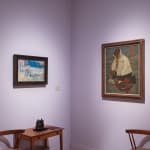Prunella Clough 1919-1999
Fisherman, c1949
oil on canvas
30 1/8 x 24 1/4 in
76.5 x 61.5 cm
76.5 x 61.5 cm
Between 1946 and 1951 Prunella Clough made frequent visits to Southwold, on the Suffolk coast, where her parents acquired a second home. It was here that her fascination with fishermen...
Between 1946 and 1951 Prunella Clough made frequent visits to Southwold, on the Suffolk coast, where her parents acquired a second home. It was here that her fascination with fishermen began. Many of her finest pictures from this period are of this subject. The nearby Lowestoft initially had for her less appeal, but after meeting the painter David Carr, with whom she established a lasting friendship and often went on drawing expeditions to Lowestoft, she switched her attention to this more industrial fishing port and the activities that went on within it.
This painting, focusing on a single figure as he prepares to gut a fish, is probably associated with Southwold. Yet the strength of the overall design is characteristic of her Lowestoft scenes, where the figures are not only locked into their task but also the environment. The most notable example of this is Clough's Lowestoft Harbour (1951), bought by the Arts Council after the picture was commissioned for their '60 Paintings for '51', an event that helped celebrate the Festival of Britain. Fisherman is less complex compositionally, but it likewise represents a moment of arrival, as she leaves behind her former Neo-Romanticism in favour of a tougher form of realism, in keeping with the new dignity bestowed on the ordinary man or woman by new social legislation. In particular, she began to make use of a semi-cubist faceting of form, or 'carpentering', as she self-mockingly called it, which gives her fishermen and other scenes of labour a sense of strength and definiteness.
Text by Frances Spalding
This painting, focusing on a single figure as he prepares to gut a fish, is probably associated with Southwold. Yet the strength of the overall design is characteristic of her Lowestoft scenes, where the figures are not only locked into their task but also the environment. The most notable example of this is Clough's Lowestoft Harbour (1951), bought by the Arts Council after the picture was commissioned for their '60 Paintings for '51', an event that helped celebrate the Festival of Britain. Fisherman is less complex compositionally, but it likewise represents a moment of arrival, as she leaves behind her former Neo-Romanticism in favour of a tougher form of realism, in keeping with the new dignity bestowed on the ordinary man or woman by new social legislation. In particular, she began to make use of a semi-cubist faceting of form, or 'carpentering', as she self-mockingly called it, which gives her fishermen and other scenes of labour a sense of strength and definiteness.
Text by Frances Spalding
Provenance
Coubro & Scrutton LtdPrivate Collection, U.K, acquired from the above in the 1970s
Join our mailing list
* denotes required fields
We will process the personal data you have supplied to communicate with you in accordance with our Privacy Policy. You can unsubscribe or change your preferences at any time by clicking the link in our emails.



